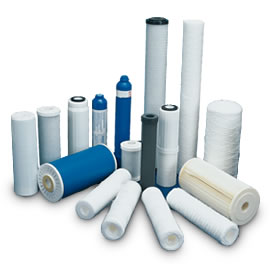I often get approached by clients and prospective clients asking about water filtration and/or their desire to have a water filter installed. I usually ask one question that stops most in their tracks. “What are you wanting to filter out of your water?”
Let’s break this down a little: There are an overabundance of devices, fixtures & apparatus that claim to “filter,” alter or condition the native state of your water. However, there are also many different “medias” (aka filters) that filter a wide range of particulates, chemicals & bacteria etc. (see images below).
There are “whole-house” filters, “point of use” filters and many other types of filters. All of the aforementioned filters have varying “housing” units to which the filters attach. Most filters or other media are proprietary to the manufacturer of the filter “housing,” so you must consider the cost & moreover the availability of these filters in the long-run. I’ve done many service calls to remove & abandon filtration systems due to the fact that replacement filters are discontinued, unavailable or too expensive!

Let’s get back to the original question, what do you hope to remove from your water by filtering it in the first place? I would respectfully point out that most clients don’t have a solid answer. Start by gaining the knowledge of what your water source contains that is undesirable or that you may be sensitive to, then seek to find the filter that’s right for you. Do you want “it” removed entirely from all the water entering your home – or perhaps just “one glass at a time” at the sink?
Contact your water service provider for the most recent water quality report or have your water tested by an independent facility. The latter of the two can carry a cost. Have you ever heard the saying “everything is enjoyed by comparison?” It just so happens that most of Portland and the surrounding Tri-County area gets our water source from the Bull Mountain watershed (see link below).
http://www.portlandoregon.gov/water/29784
This is pretty good stuff already compared to some other areas in our great country! Personally, I don’t blink an eye to a tall glass of local bull mountain watershed water for a drink for myself or my family. Please note that this is my opinion only, we would prefer that you educate yourself as to what any water source contains that may adversely affect you.
We don’t have a recommendation for any one filtration system or presume to know what is best for you and yours. So we do recommend that if you still want a filtration system of any kind – ask yourself first – what is it you’re wanting to accomplish? Then, are you prepared to invest in maintaining it? Do some digging around and you’ll quickly find many companies claiming to have the very next best thing in the filter department – but you can decide on that for yourself.
You might be inclined to get an all around multi-purpose filter, only to find that levels of what you’re trying to remove are hardly present. If there were only one or two things you want removed or filtered from your water – get filters that do just that!
Let’s not try fixing what isn’t broken.
Ti Sutherland, Master Plumber – Sutherland Plumbing, LLC (CCB#200460)












